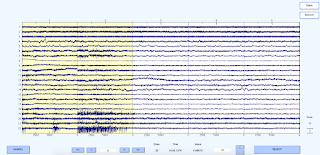Week 6 (Jason Chang)
With only
a week of immersion left, I have been focusing all my time on developing a preliminary
proof-of-concept protocol for automating EEG artifact removal in MATLAB. Admittedly,
it has been very challenging at times, especially given my limited neurology
and programming experience, but I have made significant progress as of recently
with the assistance of Dr. Mangat and Dr. Forgács. Last week, I began using
EEGLAB, an interactive EEG analysis toolbox in MATLAB, to perform independent
component analysis (ICA) on selected datasets from the subarachnoid hemorrhage
(SAH) study. After ICA is applied, EEGLAB has different built-in signals
processing functions to mark and remove components containing any artifacts.
With several methods to choose from, I consulted with Dr. Forgács on Thursday
to seek his clinical expertise.
Figure
1. Individual component analysis (ICA) to reject artifacts
by visual inspection of continuous EEG signals
Figure
2. Removing ICA components using 2-D scalp
mapping of continuous EEG signals
Dr. Forgács
typically removes artifacts manually to avoid user subjectivity associated
with ICA. Moreover, his lab members have developed their own ICA script in
MATLAB separate from EEGLAB. However, Dr. Forgács suggested looking through each
channel for ICA components by visual inspection and using 2-D scalp map plots,
both of which can be done in EEGLAB (Figure
1 and Figure 2). He also
recommended analyzing the EEG power spectrum to observe the voltage vs. frequency
spectral response for each dataset. Using the power spectrum, quantitative markers
can be assessed to check for artifacts in pre- and post-processed EEG signals. Unfortunately,
the power spectrum script developed by his lab does not work properly on my
laptop – a reoccurring problem that I continue to encounter all summer. Additionally,
Dr. Forgács mentioned that ICA can be especially difficult if the isolated artifact(s)
are not consistent. For example, if a patient blinked or turned their head just
once during an EEG recording, ICA would be ineffective and could potentially disturb
the signals of interest.
Going
forward, Dr. Mangat and I agreed that it would be very time-consuming if I
attempted to run ICA with my limited ability to identify complex artifacts. Instead,
I will be working on my final report and poster over the next week. I plan to
document this protocol, in addition to any major troubleshooting errors I faced
along the way, so that whoever takes over this project next will have a
preliminary framework already in place.



This comment has been removed by the author.
ReplyDelete